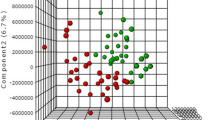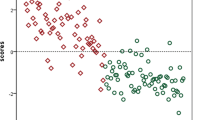Abstract
Biochemical markers are crucial to the development of early diagnosis of infantile autism. The blood concentrations of neuroanalytes epinephrine, norepinephrine, dopamine, and serotonin were elevated in autistic subjects (n = 13) as compared to normal controls (n = 10). Autistic subjects had peptide patterns (peaks I-V, Sephadex G-25) that were different from those of normal controls. Methionine-enkephalin has been tentatively identified from fraction I of autistic subjects by HPLC as one of a large number of peptides that appears to be elevated. The HPLC chromatographic patterns of fraction V from all autistic subjects show a peak with retention time of 7.6 min. The HPLC of control urine fraction V revealed no comparable peaks.
Similar content being viewed by others
References
American Psychiatric Association (1980)Diagnostic and statistical manual of mental disorders. 3rd ed. American Psychiatric Assoc., Washington, DC.
Bohus B., Kovacs G. L., and de Wied D. (1978) Oxytoxin, vasopressin and memory: Opposite effects on consolidation and retrieval processes.Brain Res. 157, 414–417.
Boullin D. J. and O’Brien R. A. (1972) Uptake and loss of14C-dopamine by platelets from children with infantile autism.J. Autism Child. Schizo. 2, 67–74.
Boullin D. J., Coleman M., and O’Brien R. A. (1970) Abnormalities in platelet 5-hydroxytryptamine efflux in patients with infantile autism.Nature 226, 371–372.
Boullin D. J., Coleman M., O’Brien R. A., and Rimland B. (1971) Laboratory predictions of infantile autism based on 5-hydroxytryptamine efflux from blood platelets and their correlation with the Rimland E-2 score.J. Autism Child. Schizo. 1, 63–71.
Causon R. C., Carruthers M. E., and Rodnight R. (1981) Assay of plasma catecholamines by liquid chromatography with electrochemical detection.Anal. Biochem. 116, 223–226.
Cohen D. J., Shaywitz B. A., Johnson W. T., and Bowers M. Jr. (1974) Biogenic amines in autistic and atypical children.Arch. Gen. Psychiat. 31, 845–853.
Coleman M. (1978) Serotonin in behavioral and intellectual dysfunction of children, inSerotonin in Health and Disease, vol. III:The Central Nervous System (Essman W. B., ed.) pp. 293–316. Spectrum Publications, New York, NY.
Coleman M. and Gillberg C. (1985) Biochemical studies, inThe Biology of The Autistic Syndromes (Coleman M. and Gillberg C., eds.) pp. 75–104. Praeger Scientific, New York, NY.
Damasio A. R. and Murer R. G. (1978) A neurological model for childhood autism.Arch. Neurol. 35, 777–786.
Eadie M. J. and Tyrer J. H. (1983) Disturbances of synaptic transmission, inBiochemical Neurology (Eadie M. J. and Tyrer J. H., eds.), pp. 217–254. Alan R. Liss, New York, NY.
Emson P. C. (1979) Peptides as neurotransmitter candidates in the mammalian CNS.Prog. Neurobiol. 13, 61–116.
Garnier C., Barthelemy C., Garreau B., Jouve J., Muh J. P., and Lelord G. (1983) Les anomalies des monoamines et leur enzymes dans Fautisme de l’enfant.Encephale 9, 201–262.
Gillberg C., Trygstad O., and Foss I. (1982) Childhood psychosis and urinary excretion of peptides and protein-associated peptide complexes.J. Autism Dev. Disord. 12, 229–241.
Goldstein M., Mahanand D., Lee J., and Coleman M. (1976) Dopamine-β-hydroxylase and endogenous total 15-hydroxyindole levels in autistic patients and controls, inThe Autistic Syndromes (Coleman M., ed.) pp. 57–63, North-Holland, Amsterdam.
Himwich H. E., Jenkins R. L., Fujimori M., Narasimhachari N., and Ebersole M. (1972) A biochemical study of early infantile autism.J. Autism Child. Schizo. 2, 114–126.
Kanner L. (1943) Autistic disturbances of affective contact.Nerv. Child. 2, 217–250.
Kanner L. (1958) The specificity of early infantile autism.Z. Kinderpsychiatr. 25, 108–113.
Katsui T., Okuda M., Usuda S., and Koizumi T. (1986) Kinetics of3H-serotonin uptake by platelets in infantile autism and developmental language disorder (including five pairs of twins).J. Autism Dev. Disord. 16, 69–76.
Lucas A. R., Warner K., and Gottlieb J. S. (1971) Biological studies in childhood schizophrenia.Biol. Psychiat. 3, 123–128.
MacCulloch M. J. and Williams C. (1971) On the nature of infantile autism.Acta Psych. Scand. 47, 295–314.
Moss R. I. and Foreman M. M. (1976) Potentiation of lordosis behaviour by intrahypothalmic infusion of synthetic luteinizing hormone releasing hormone.Neuroendocrinology 20, 176–181.
Ornitz E. M. and Ritvo E. R. (1968) Perceptual inconstancy in early infantile autism: A critical review.Am. J. Psychiat. 18, 609–621.
Reeve J., Yamada T., Chew P., Walsh J. H., and Dimaline R. (1982) Rapid highyield purification of neuropeptides from canine intestinal muscle.J. Chromatogr. 229, 57–65.
Reichelt K. L. and Edminson P. D. (1977) Peptides containing probable transmitter candidates in the central nervous system, inPeptides in Neurobiology (Gainer H., ed.) pp. 171–181. Plenum, New York, NY.
Reichelt K. L., Hole K., Hamberger A., Saelid G., Edminson P. D., Braestrup C. B., Lingjaerde O., Ledaal P., and Orbeck H. (1981) Biologically active peptide-containing fractions in schizophrenia and childhood autism, inNeurosecretion and Brain Peptides (Martin J. B., Reichlin S., and Bick K. L., eds.) pp. 627–643. Raven, New York, NY.
Rimland B. (1971) The differentiation of childhood psychoses: An analysis of checklists for 2,218 psychotic children.J. Autism Child. Schizo. 1, 161–174.
Ritvo E. R., Yuwiler A., Geller E., Ornitz E. M., Saeger K., and Plotkin S. (1970) Increased blood serotonin and platelets in early infantile autism.Arch. Gen. Psychiat. 23, 566–572.
Rosen H. (1957) A modified ninhydrin colorimetric analysis for amino acids.Arch. Biochem. Biophys. 67, 10–15.
Rutter, M. (1974) The development of infantile autism.Psychol. Med. 4, 147–163.
Sanker D. V. S., Gold E., Phipps E., and Sankar D. B. (1962) General metabolic studies on schizophrenic children.Ann. NY Acad. Sci. 96, 392–398.
Schopler E., Reichler R. J., De Villis R. F., and Daly K. (1980) Toward objective classification of childhood autism: Childhood autism rating scale (CARS).J. Autism Dev. Disord. 10, 91–103.
Shaywitz B. A., Cohen D. J., and Bowers M. B. (1975) Reduced cerebrospinal fluid 5-hydroxyindole acetic acid and homovanillic acid in children with epilepsy.Neurology 25, 72–79.
Stevens J. R. (1973) An anatomy of schizophrenia?Arch. Gen. Psychiat. 29, 177–189.
Trygstad O. E., Reichelt K. L., Foss I., Edminson P. D., Saelid G., Bremer J., Hole K., Orbeck H., Johansen J. H., Boler J. B., Titlestad K., and Opstad P. K. (1980) Patterns of peptides and protein-associated-peptide complexes in psychiatric disorders.Br. J. Psychiat. 136, 59–72.
Urban I. V. and de Wied D. (1978) Neuropeptides: Effects on paradoxical sleep and theta rhythm in rats.Pharmacol. Biochem. Behav. 8, 51–58.
Victor G. (1983)The Riddle of Autism: A Psychological Analysis. D.C. Heath and Company, Boston, MA.
Wise D. and Stein L. (1973) Dopamine-β-hydroxylase deficits in the brains of schizophrenic patients.Science 181, 344–347.
Yuwiler A., Plotkin S., Geller E., and Ritvo E. R. (1970) A rapid accurate procedure for the determination of serotonin in whole human blood.Biochem. Med. 3, 426–436.
Yuwiler A., Ritvo E. R., Bald D., Kipper D. and Koper A. (1971) Examination of circadian rhythmicity of blood serotonin and platelets in autistic and nonautistic children.J. Autism Child. Schizo. 1, 421–435.
Yuwiler A., Ritvo E., Geller E., Glousman R., Schneiderman G., and Matsuno D. (1975) Uptake and efflux of serotonin from platelets of autistic and nonautistic children.J. Autism Child. Schizo. 5, 83–98.
Author information
Authors and Affiliations
Rights and permissions
About this article
Cite this article
Israngkun, P.P., Newman, H.A.I., Patel, S.T. et al. Potential biochemical markers for infantile autism. Neurochemical Pathology 5, 51–70 (1986). https://doi.org/10.1007/BF03028036
Received:
Accepted:
Issue Date:
DOI: https://doi.org/10.1007/BF03028036




